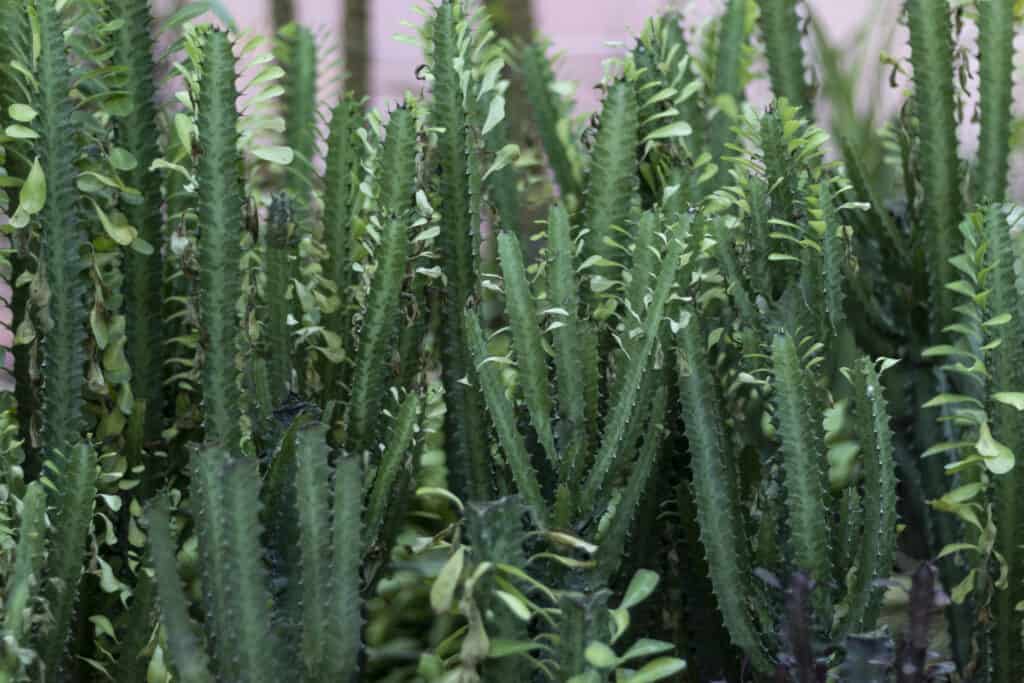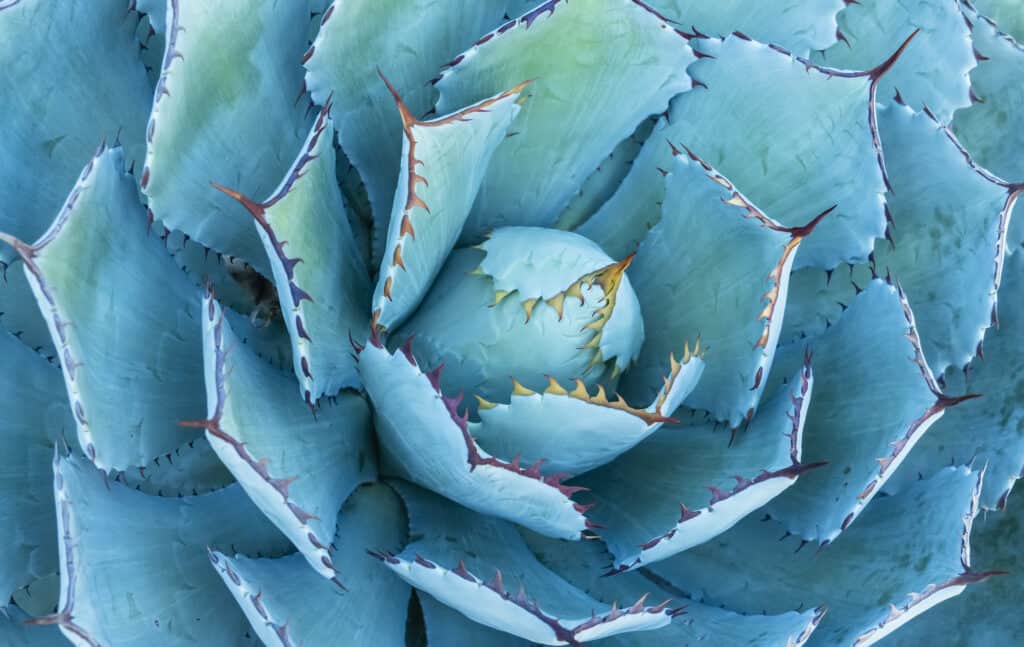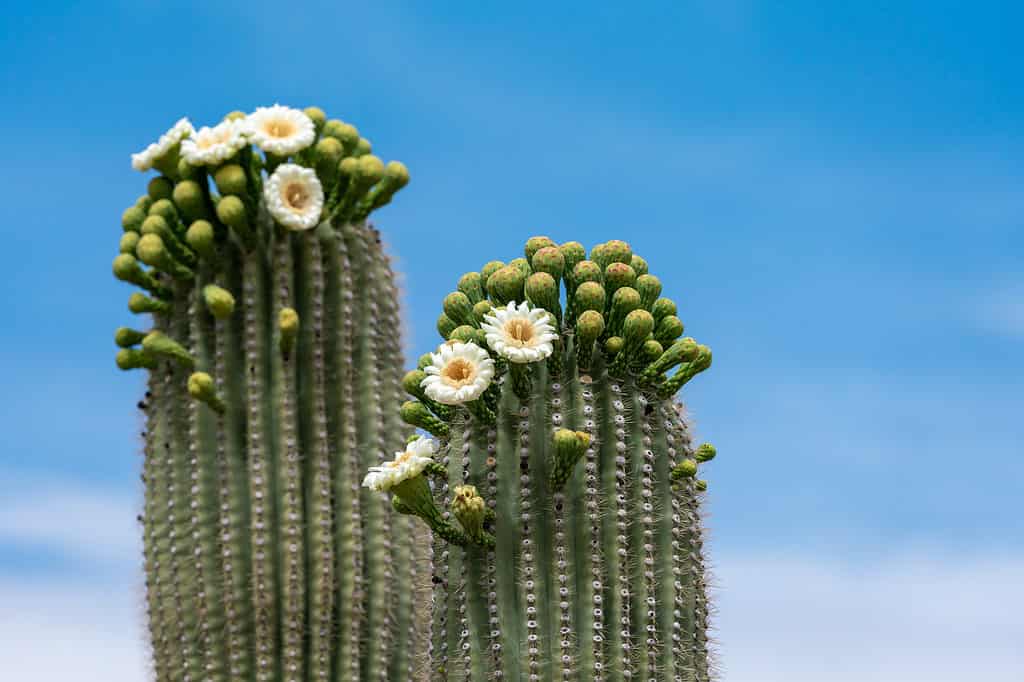There are thousands of types of succulents, ranging from tiny half-an-inch-tall lithops to baobabs reaching upwards of 80 feet. If you’ve wondered just how big a succulent can get, you’re in the right place. Let’s discover tall succulents that suit a drought-prone yard or a large indoor container.
What Are Succulents?
Succulent is an umbrella term for plants that store water in their roots, stems, or leaves. Several plant families have succulent plants included in their ranks. Keep in mind that succulent is not a family or genus type.
Succulents store water because they tend to grow in arid, dry places. Their fleshy water retaining parts are very efficient water storage units, but some succulents have other clever ways to manage scant water resources.
This includes innovations like shallow roots so they can suck up liquid before it’s evaporated by the sun and wrinkled, ridged skin that inflates like a balloon to capture lots of water during rainstorms.
Up to 1/3 of all succulents are native to South Africa, but they grow in every continent except Antarctica. They’ve had a popularity resurgence in recent years to the point where some species of wild succulents are poached and are now in danger of becoming extinct in the wild.
What Types of Tall Succulents are There?
The tallest succulents are stunning plants that range in flower color, shape, size and growth rates. Here are some of the most popular tall succulents.
Euphorbia trigona

Euphorbia trigona is an African milk tree.
©iStock.com/Bilal photos
Also known as the African milk tree, this tall succulent is native to, you’ve guessed it, southern and central Africa! It can reach a whopping ten feet tall on slim long stems but only spreads two feet wide.
Its thick fleshy limbs are a rich green, and its flowers are bright red. This is an excellent tall succulent to add height to dry gardens. They also make great additions to rooms with tall ceilings.
Aeonium Arboreum
The tree houseleek or Irish rose is a succulent that can reach three feet tall. It has sparse brown, fleshy branches topped with lime green leaves formed like rosettes. In summer, yellow star-shaped flowers emerge.
Aeoniums are native to the Canary Islands and North Africa. They’re popular for rockeries, drought-prone flower beds, and terracotta pots.
Agave Americana

Close-up of an agave plant.
©iStock.com/kynny
This popular tall succulent reaches five feet in height and is better known as an easy-to-manage century plant.
It has long thin fleshy grey-green leaves with small spikes along the margins. It is said to flower only once in its lifetime, which is why it’s called the century plant. After flowering, which takes 25-30 years, the plant begins to die.
Native Americans used its sap to make tequila!
Austrocylindropuntia subulata
One of the largest succulents on this list is Eve’s needle. This massive succulent can reach 13-15 feet tall!
The Austrocylindropuntia subulata is a cactus native to the Peruvian Andes. It has cylindrical leaves on its thick tall stem. It is beautiful and unusual, but it also has many thin sharp needles, hence its name Eve’s Needle. In its native land, it’s cultivated to create a living fence!
Crassula Ovata

If you want your short jade plant to reach an impressive height of 15 feet, you will need a lot of patience as it’s very slow growing.
©svf74/Shutterstock.com
Jade plants are common houseplant succulents that can reach a foot or more. In the wild, they can grow up to 15 feet.
Crassula ovata is native to South Africa and Mozambique. It has a thick brown stem covered in jade-green horizontal fleshy leaves which grow in opposite pairs. If it’s happy, it will produce masses of star-shaped white flowers.
If you want your short jade plant to reach an impressive height of 15 feet, you will need a lot of patience as it’s very slow growing.
Cyphostemma Juttae
A South African native that’s also called the grape tree, this beauty can reach six feet tall. It’s an unusually tall succulent that’s in high demand! Its foliage grows in spirals around its thick brown trunk, and collectors prize this plant due to its unique features.
In summer, it produces green-yellow flowers that mature into grape-like berries. Although they look tasty, the berries are toxic.
Kalanchoe Beharensis
Better known as the felt bush, elephant’s ears, or even the velvet leaf kalanchoe, this fleshy succulent can reach 16 feet and is native to Madagascar.
It’s a popular type of tall succulent because its trunk is woody, and its 14-inch arrow-shaped leaves are soft. The plant is covered with felt-like hairs to help preserve moisture. Often referred to as “fangs,” the plant’s leaf undersides are rounded.
If it is happy, this plant will produce green-yellow flowers in the summer.
Pachypodium lamerei
This Madagascar-native palm can reach 20 feet tall but can take over a decade. It grows well in a yard or as a houseplant if it gets plenty of sun.
This isn’t actually a palm but a tall succulent with a thick thorny stem and a cluster of lance-shaped green leaves at the very top. In summer, clusters of yellow-white flowers arch above its leaves.
Saguaro (Carnegiea gigantea)

Saguaro Cactus Flowers.
©JayPierstorff/Shutterstock.com
The state flower of Arizona had to be a succulent, given the dry conditions!
The saguaro cactus has a tall trunk that can reach 40 feet tall! The cactus springs to mind when you think about the desert southwest. It’s pitchfork-shaped and covered in spines, but when it flowers, pretty white daisy-like blooms appear on the tips of its green fleshy branches. A word of warning, it can take 50 years to flower, so patience is required!
This succulent is oh-so-tough. Its drought-proof nature ensures it needs very little to grow. This plant is a great choice for structural gardens with poor-quality soil. This cactus is home to several bird species, including Gila woodpeckers, who hollow out small nests in its fleshy top branches.
What’s the Tallest Succulent?
The tallest succulents in the world are thought to be Adansonia digitata, commonly known as African Baobabs, which can reach 82 feet tall. They’re native to Africa and the southern Arabian Peninsula, and some have been carbon dated to 2,000 years old.
According to the Guinness World Records, The tallest ever homegrown cactus was a Cereus Peruvians that reached 110 feet tall. It was grown at the Shri Dharmasthala Manjunatheshwara College of Dental Sciences (India) in Dharwad, Karnataka, India. It’s still growing!
How to Look After Tall Succulents?
Tall succulents need the same care as small succulents.
The best way to care for a tall succulent is to find a bright sunny spot outside or a bright, indirectly lit position indoors. This is because windowpane glass magnifies sunlight and scorches the plant’s limbs. Succulents need at least six hours of sunlight daily to thrive.
Another really important aspect is its roots. Succulents need well-drained compost, so water doesn’t cling to their roots. Add perlite to compost or buy specific cacti compost for the best results.
And last but not least, watering.
Watering a succulent is different from other houseplants because they need very little. Weeks can pass before a succulent needs moisture. There aren’t specific rules, but when the soil is dry on top and dry down to an inch or so if you press your finger into the soil, it’s time to water the plant.
The Best Way to Water a Succulent
Succulents need water around their roots, not on their foliage. Pop your succulent in a sink, or if it’s tall, in a bucket, and let it soak. Let it drain clear before replacing it.
This technique ensures your succulent won’t sit in a container of soggy soil and slowly rot.
Are Succulents Toxic to Pets?
Some are. The ASPCA’s list of toxic plants contains details of toxic succulents.
Which are the Best Types of Tall Succulents?
The best tall succulents are ones that suit your lifestyle.
For example, if you have kids and pets, favor succulents without toxic sap to stay safe. A toxic euphorbia or Eve’s needle succulent may not be ideal, but an agave Americana with non-toxic sap may be a great option!
Up Next
- Are Succulents Poisonous to Dogs or Cats?
- The 10 Largest trees in The World
- Discover the Largest Cactus in the World
The photo featured at the top of this post is © JayPierstorff/Shutterstock.com
Sources
- Guinness World Records, Available here: https://www.guinnessworldrecords.com/world-records/tallest-homegrown-cactus-
- Arizona Journals, Available here: https://journals.uair.arizona.edu/index.php/radiocarbon/article/viewFile/3705/pdf
- Missouri Botanical Gardens, Available here: http://www.missouribotanicalgarden.org/PlantFinder/PlantFinderDetails.aspx?taxonid=277943&isprofile=0&cv
- ASPCA, Available here: https://www.aspca.org/pet-care/animal-poison-control/toxic-and-non-toxic-plants
- The Guardian, Available here: https://www.theguardian.com/us-news/2022/mar/20/california-succulent-smuggling-dudleya
Thank you for reading! Have some feedback for us? Contact the AZ Animals editorial team.






